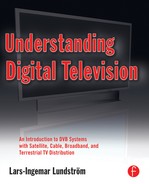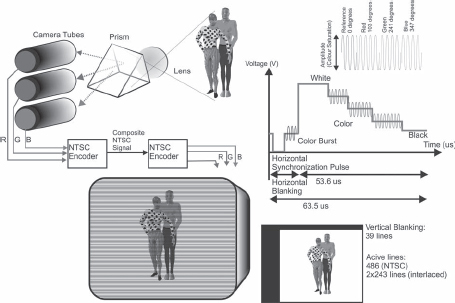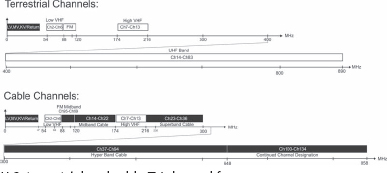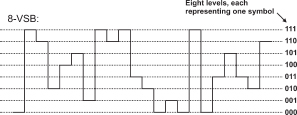A |
Digital Television in North America |
| APPENDIX |
FIGURE
A.1
North and South America have different technical standards than Europe, but the differences are not that large.
This book is full of European examples, and DVB was started up in Europe. However, most of the book's content is applicable everywhere in the world and DVB is now in use all over the world. For example, in the U.S., Dish Network is based on the DVB standard.
When it comes to broadcasting, North America is very often considered as very different from Europe, or Europe as very different from North America. However the differences are really quite small as I shall try to explain in this appendix.
It is a well-known fact that U.S. reception equipment cannot be used in Europe and vice versa. However, the compatibility has increased in the last decade. Today you find TV sets in Europe that handle NTSC recordings on DVDs without any problems at all. And the TV sets, which very often originate from the same factories in Asia, work with both European and North American signals. The manufacturers try to establish some kind of industrial world standard for all equipment. Of course this is the most economical solution for everyone.
COMMERCIAL TELEVISION SYSTEMS
North America has a long history in television, especially when it comes to commercializing the media, and this is the most significant difference.
In the U.S., a 525 line analog system has been used for a long time. System M has 486 active lines with interlaced scanning of 243 lines in 60 frames per second giving 30 pictures per second. This is to be compared to the European 625 line system with 576 active lines with interlaced scanning of 288 active lines in 50 frames per second, resulting in 25 pictures per second.
The choice of frame rate—60 Hz in North America and 50 Hz in Europe—is due to the AC power frequency. In the early days of television, it was easier to get rid of disturbances from power supplies and power lines using the same frame rate as the AC power frequency. In today's TV sets, there are other means to avoid these problems, so you can easily watch 60 Hz TV in Europe and 50 Hz signals in the U.S.
North America was early with color TV and established the NTSC system, developed in the 1950s and 60s, which were based on the black-and-white picture transmitted at near-full resolution.
A black-and-white picture on the American analog standard requires approximately 4 MHz bandwidth and in Europe about 5 MHz bandwidth. Of this, one MHz was removed in the upper frequency range of the video spectrum so the signal occupies the spectrum between 0 to 3 and 0 to 4 MHz respectively. In the spectral area between 3 and 4 (NTSC) or 4 and 5 MHz (PAL), a phase modulated subcarrier is put around the frequency 3.58 MHz (NTSC) and 4.43 MHz (PAL) respectively. The phases of the carrier indicate the color tone and the amplitude symbolizes the saturation of the color.
NTSC is really very similar to PAL (Phase Alternating Line), as seen in Figure A.2. The only real difference is in the meaning of phase alternating line—the phase reference (the burst) and the phase of the color signal on the line are alternated plus or minus 90 degrees for each consecutive line. This makes the PAL signal less sensitive to color tone problems because the radio waves are reflected at buildings, mountains and aircraft. Other than that, both systems are quite similar.
Analog television was based on a frequency modulated subcarrier for the audio. In the North American system the sound subcarrier is located at 4.5 MHz, while in Europe it is mostly at 5.5 MHz or 6.0 MHz (United Kingdom and Ireland). Eastern Europe has other versions of the 625 line system.
Many South American countries use NTSC just as in the U.S. and Canada but in some countries as in Brazil the unusual combination of PAL and the 525 line system has been used.
NTSC is also to be found in many Asian countries as in Japan and South Korea.
FIGURE
A.2
The principles for the NTSC system are quite similar to the European PAL system.
STEREO SOUND
Late in the 1980s, it became evident that people wanted stereo sound with the TV transmissions. One simple way to do this is adding a second frequency modulated subcarrier.
In the United States the MTS system (Multi-Channel Television Sound) was introduced. This works in a way that is very similar to ordinary pilot tone FM stereo transmissions. At the same time, the German A2 systems and the digital NICAM systems were introduced in Europe.
FREQUENCY PLANNING AND THE TRANSFER TO DIGITAL TV IN NORTH AMERICA
Terrestrial and cable TV in North America is based on 6 MHz channels, which was a suitable bandwidth for the 525 line NTSC channels. And the same channel bandwidth is used in cable TV. A difference between Europe and the U.S. is that the same bandwidth is used in all frequency ranges. In Europe there are 7 MHz channels in the VHF bands while 8 MHz is used in the UHF bands.
Figure A.3 shows the channels plans for North America.
Note that the cable networks use almost all the frequencies that can be fitted into the cables. This means that the cables carry channels that are in frequency ranges that are reserved for other services in the radio spectrum, so the cables must be well-shielded. The most dramatic is the use of the FM band for TV channels, cable channels 95–99.
FIGURE
A.3
U.S. terrestrial and cable TV channel frequency ranges.
In 1997, the Federal Communications Commission set the rules for the future of digital TV in the U.S. When digital TV was to be introduced, the broadcasters should also move to HDTV. The ATSC (Advanced Television Standards Committee) system has been adopted by the U.S., Canada, Mexico, Argentina, Mexico and South Korea. In the terrestrial portion of the ATSC system, just as in analog terrestrial television, amplitude modulation is used. Using 8-VSB means that the level of the carrier signal varies between eight different levels just as is shown in Figure A.4.
Instead of combined amplitude and phase angles, the symbols (each containing three bits) are defined by the amplitude of the carrier. In reality, the signal is a bit more complicated than this. A pilot signal is added to the baseband signal that is shown in Figure A.4.
FIGURE
A.4
The baseband ATSC digital terrestrial signal is amplitude modulated with eight levels, each representing a set of three bits. A pilot is also added, giving the final signal a somewhat different structure.
The 8-VSB (vestigial side band) signal in a 6 MHz channel allows for a maximum useful bitrate of 19.39 Mbit/s which is enough to house an MPEG-2 compressed HDTV signal.
As in Europe the introduction of digital cable TV has been slower than satellite and terrestrial in the U.S. Though 8-VSB is used for terrestrial transmissions, cable operators may also use 16-VSB or 256-QAM, which provide significantly higher throughput in a 6 MHz channel. Due to the more stable conditions in cables than over the air, such methods are possible. Using 256-QAM puts us quite close to the DVB-C standard used for cable in other countries.
ATSC is, just like the DVB standard, based on the use of MPEG-2 and the standards have many other technical similarities. The largest difference between North America and Europe is the move directly from analog terrestrial TV to digital terrestrial HDTV. In Europe, digital terrestrial TV is adding more standard definition channels to the terrestrial networks.
The ATSC 8-VSB signal is less sensitive to noise than the DVB-T signal. The use of the bandwidth is also somewhat more efficient than the COFDM used in DVB-T. However, the DVB-T signal is better when it comes to reusing the same frequencies in single frequency networks, which may be one of the reasons DVB-T is used in Europe. Many countries are located close together and have to share the same spectrum, which is a scarce resource.
CONNECTORS AROUND THE WORLD
The most significant feature in European digital TV receivers is the use of scart cables. You do not find these scart connectors in other parts of the world. Scart connectors became mandatory in European TV sets in the 1980s. The major advantage of using scart connectors is that you can use component-encoded video signals. This was an important feature when the component encoded MAC system was introduced in some European markets. Another feature is that the scart also carries the analog stereo audio signals.
In American digital receivers, you find S-Video outputs instead of the scart outputs. This also gives you component signals, but not the RGB signals. Still, the use of S-video connection between the digital receiver and the TV set provides something that is better than the composite video signal. The audio has to be obtained separately from analog RCA or digital S/PDIF outputs.
In HDTV receivers, there are either DVI or HDMI connectors and the HDMI is surely the replacement for the scart in Europe. HDMI carries both digital audio and digital video. And the best thing of all is that it will be more or less world standard.




